Synthesis of Nanostructured TiO2 Microparticles with High Surface Area
Abstract
:1. Introduction
2. Results
2.1. Optimizing Synthesis
2.1.1. Effect of Preparation Conditions on Morphology and Photocatalytic Activity of TiO2 Particles
2.1.2. Effect of Thermal Treatment on Morphology and Photocatalytic Activity of TiO2 Particles
2.2. Investigation of Catalyst Stability
2.3. Investigation of the Degradation of Ibuprofen and Diclofenac Using the Prepared TiO2
3. Materials and Methods
3.1. Synthesis
3.2. Characterization
3.3. Photocatalytic Tests
4. Conclusions
Supplementary Materials
Author Contributions
Funding
Conflicts of Interest
References
- Matoh, L.; Žener, B.; Korošec, R.C.; Štangar, U.L. Photocatalytic Water Treatment. In Nanotechnology in Eco-Efficient Construction; Pacheco-Torgal, F., Vittoria Diamanti, M., Nazari, A., Goran Granqvist, C., Pruna, A., Amirkhanian, S., Eds.; Elsevier: Duxford, UK, 2019; Volume 4, pp. 675–702. [Google Scholar]
- Ahmed, S.N.; Haider, W. Heterogeneous photocatalysis and its potential applications in water and wastewater treatment: A review. Nanotechnology 2018, 29, 342001–342031. [Google Scholar] [CrossRef] [Green Version]
- Kanakaraju, D.; Glass, B.D.; Oelgemöller, M. Titanium dioxide photocatalysis for pharmaceutical wastewater treatment. Environ. Chem. Lett. 2014, 12, 27–47. [Google Scholar] [CrossRef]
- Al-Mamun, M.R.; Kader, S.; Islam, M.S.; Khan, M.Z.H. Photocatalytic activity improvement and application of UV-tio2 photocatalysis in textile wastewater treatment: A review. J. Environ. Chem. Eng. 2019, 7, 103248–103265. [Google Scholar] [CrossRef]
- Crini, G.; Lichtfouse, E. Advantages and disadvantages of techniques used for wastewater treatment. Environ. Chem. Lett. 2019, 17, 145–155. [Google Scholar] [CrossRef]
- Nakata, K.; Fujishima, A. TiO2 photocatalysis: Design and applications. J. Photochem. Photobiol. C Photochem. Rev. 2012, 13, 169–189. [Google Scholar] [CrossRef]
- Schneider, J.; Matsuoka, M.; Takeuchi, M.; Zhang, J.; Horiuchi, Y.; Anpo, M.; Bahnemann, D.W. Understanding TiO2 photocatalysis: Mechanisms and materials. Chem. Rev. 2014, 114, 9919–9986. [Google Scholar] [CrossRef]
- Hashimoto, K.; Irie, H.; Fujishima, A. TiO2 Photocatalysis: A Historical Overview and Future Prospects. Jpn. J. Appl. Phys. Part 1 Regul. Pap. Short Notes Rev. Pap. 2005, 44, 8269–8285. [Google Scholar] [CrossRef]
- Lee, S.Y.; Park, S.J. TiO2 photocatalyst for water treatment applications. J. Ind. Eng. Chem. 2013, 19, 1761–1769. [Google Scholar] [CrossRef]
- Mahmoodi, N.M.; Arami, M.; Limaee, N.Y.; Tabrizi, N.S. Kinetics of heterogeneous photocatalytic degradation of reactive dyes in an immobilized TiO2 photocatalytic reactor. J. Colloid Interface Sci. 2006, 295, 159–164. [Google Scholar] [CrossRef]
- Visan, A.; Ruud Van Ommen, J.; Kreutzer, M.T.; Lammertink, R.G.H. Photocatalytic reactor design: Guidelines for kinetic investigation. Ind. Eng. Chem. Res. 2019, 58, 5349–5357. [Google Scholar] [CrossRef] [Green Version]
- Shan, A.Y.; Ghazi, T.I.M.; Rashid, S.A. Immobilisation of titanium dioxide onto supporting materials in heterogeneous photocatalysis: A review. Appl. Catal. A Gen. 2010, 389, 1–8. [Google Scholar] [CrossRef]
- Srikanth, B.; Goutham, R.; Badri Narayan, R.; Ramprasath, A.; Gopinath, K.P.; Sankaranarayanan, A.R. Recent advancements in supporting materials for immobilised photocatalytic applications in waste water treatment. J. Environ. Manag. 2017, 200, 60–78. [Google Scholar] [CrossRef] [PubMed]
- Černigoj, U.; Štangar, U.L.; Trebše, P.; Ribič, P.R. Comparison of different characteristics of TiO2 films and their photocatalytic properties. Acta Chim. Slov. 2006, 53, 29–35. [Google Scholar]
- Nawi, M.A.; Zain, S.M. Enhancing the surface properties of the immobilized degussa P-25 TiO2 for the efficient photocatalytic removal of methylene blue from aqueous solution. Appl. Surf. Sci. 2012, 258, 6148–6157. [Google Scholar] [CrossRef]
- Bowering, N.; Walker, G.S.; Harrison, P.G. Photocatalytic decomposition and reduction reactions of nitric oxide over degussa P25. Appl. Catal. B Environ. 2006, 62, 208–216. [Google Scholar] [CrossRef]
- Poulios, I.; Aetopoulou, I. Photocatalytic degradation of the textile dye reactive orange 16 in the presence of TiO2 suspensions. Environ. Technol. (UK) 1999, 20, 479–487. [Google Scholar] [CrossRef]
- Xiang, Q.; Yu, J. Photocatalytic activity of hierarchical flower-like TiO2 superstructures with dominant {001} facets. Chin. J. Catal. 2011, 32, 525–531. [Google Scholar] [CrossRef]
- Ling, Y.; Zhang, C.; Wu, J.; Xu, W.; Qi, Y.; He, P.; Zhao, L.; Guan, Y.; Zhang, Z.; Tian, Y. Enhanced photocatalytic activity of TiO2 by micrometer-scale flower-like morphology for gaseous elemental mercury removal. Catal. Commun. 2018, 116, 91–95. [Google Scholar] [CrossRef]
- Wu, Z.; Wu, Q.; Du, L.; Jiang, C.; Piao, L. Progress in the synthesis and applications of hierarchical flower-like TiO2 nanostructures. Particuology 2014, 15, 61–70. [Google Scholar] [CrossRef]
- Liu, M. Fabrication and photocatalytical properties of flower-like TiO2 nanostructures. Trans. Nonferrous Met. Soc. China 2010, 20, 2299–2302. [Google Scholar] [CrossRef]
- Song, H.; Chen, T.; Sun, Y.L.; Zhang, X.Q.; Jia, X.H. Controlled synthesis of porous flower-like TiO2 nanostructure with enhanced photocatalytic activity. Ceram. Int. 2014, 40, 11015–11022. [Google Scholar] [CrossRef]
- Liu, S.; Jaffrezic, N.; Guillard, C. Size effects in liquid-phase photo-oxidation of phenol using nanometer-sized TiO2 catalysts. Appl. Surf. Sci. 2008, 255, 2704–2709. [Google Scholar] [CrossRef]
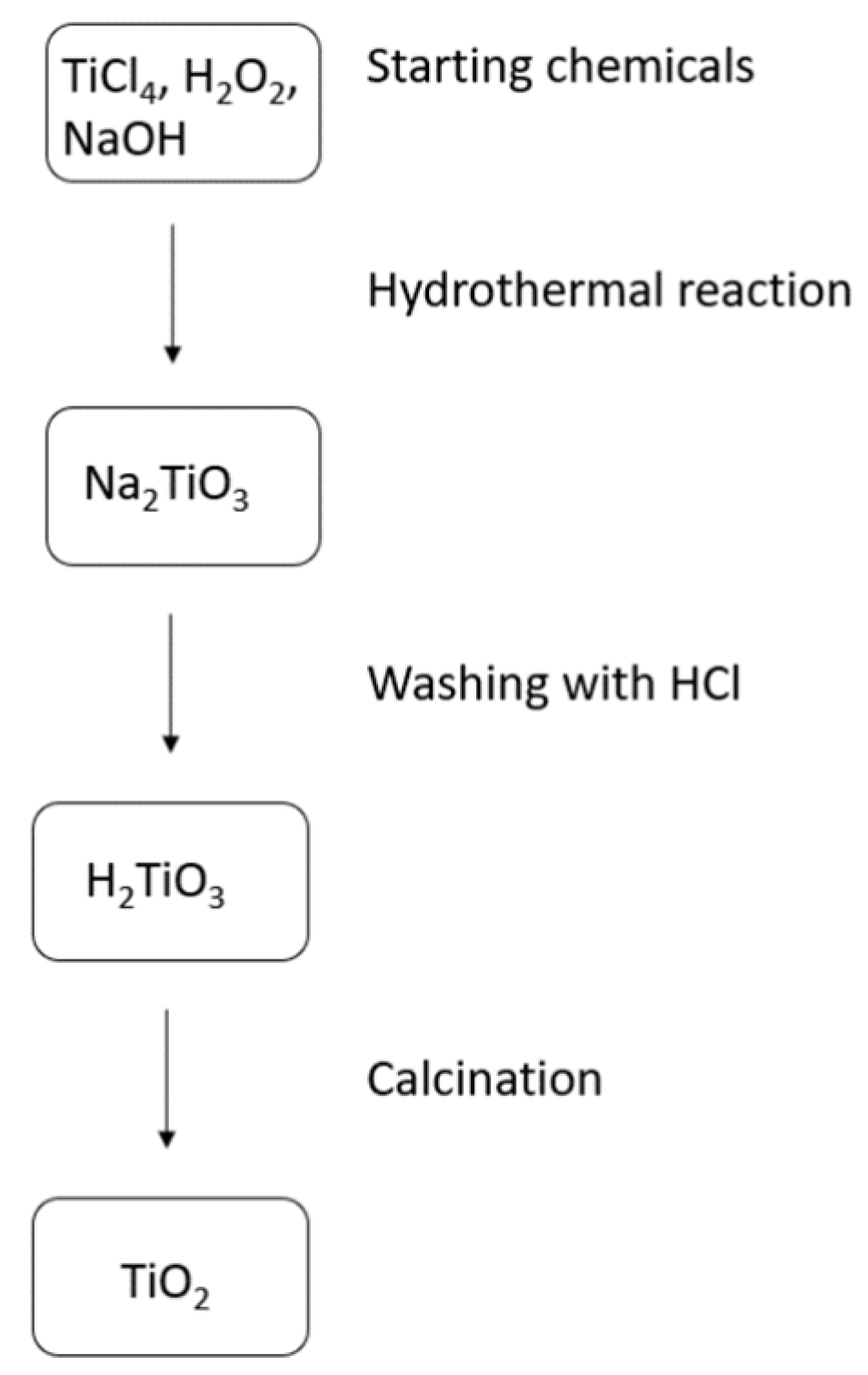
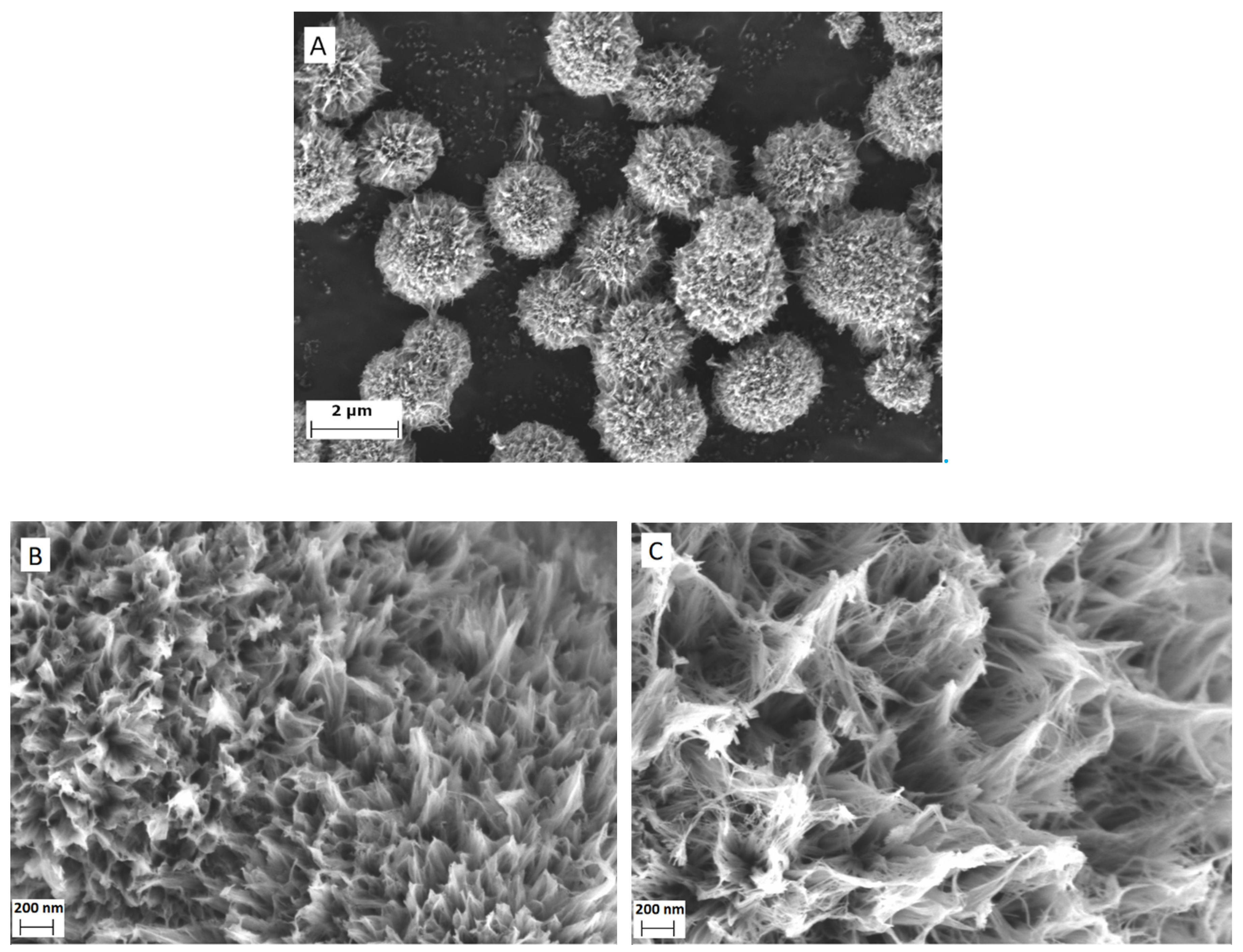
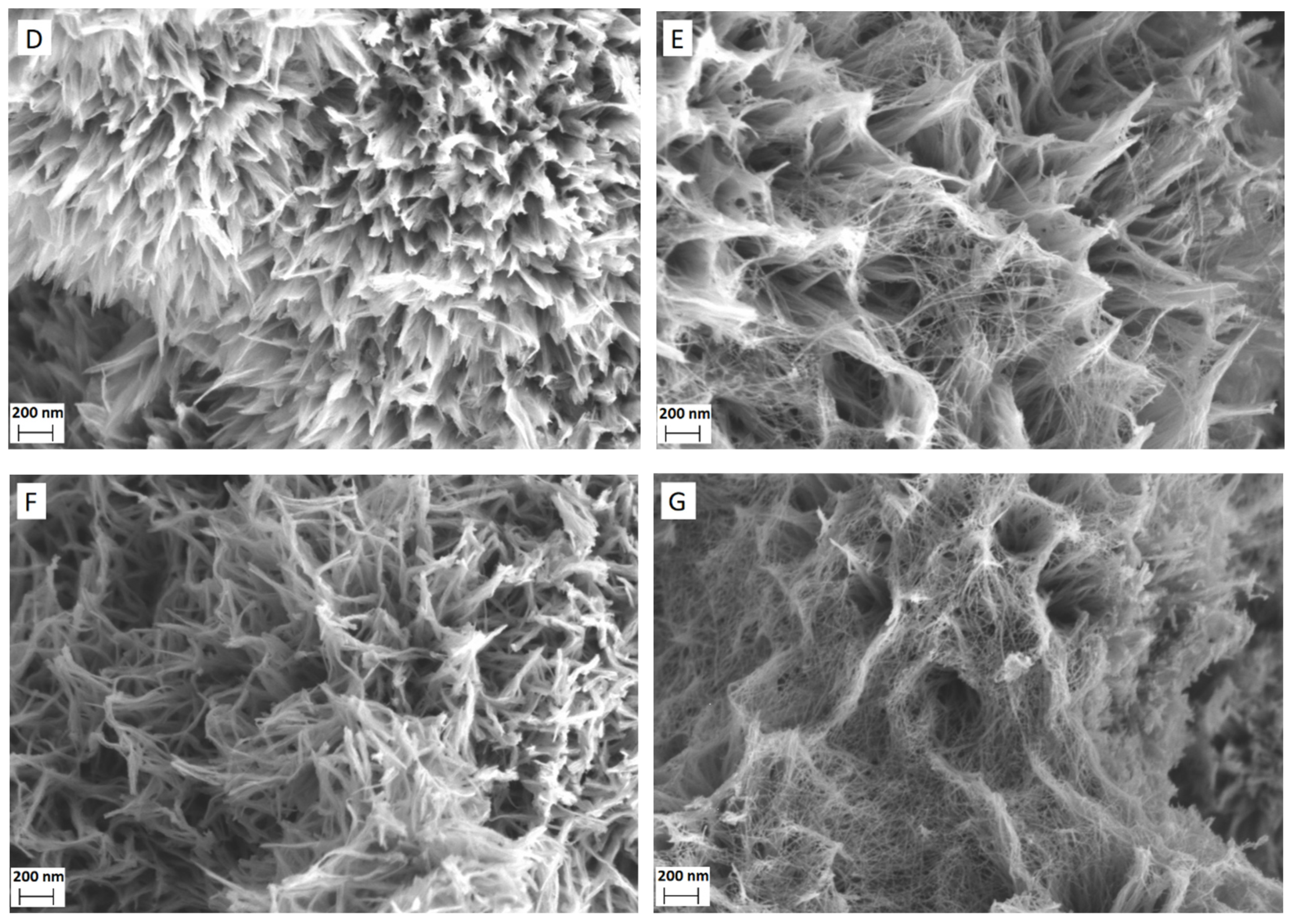
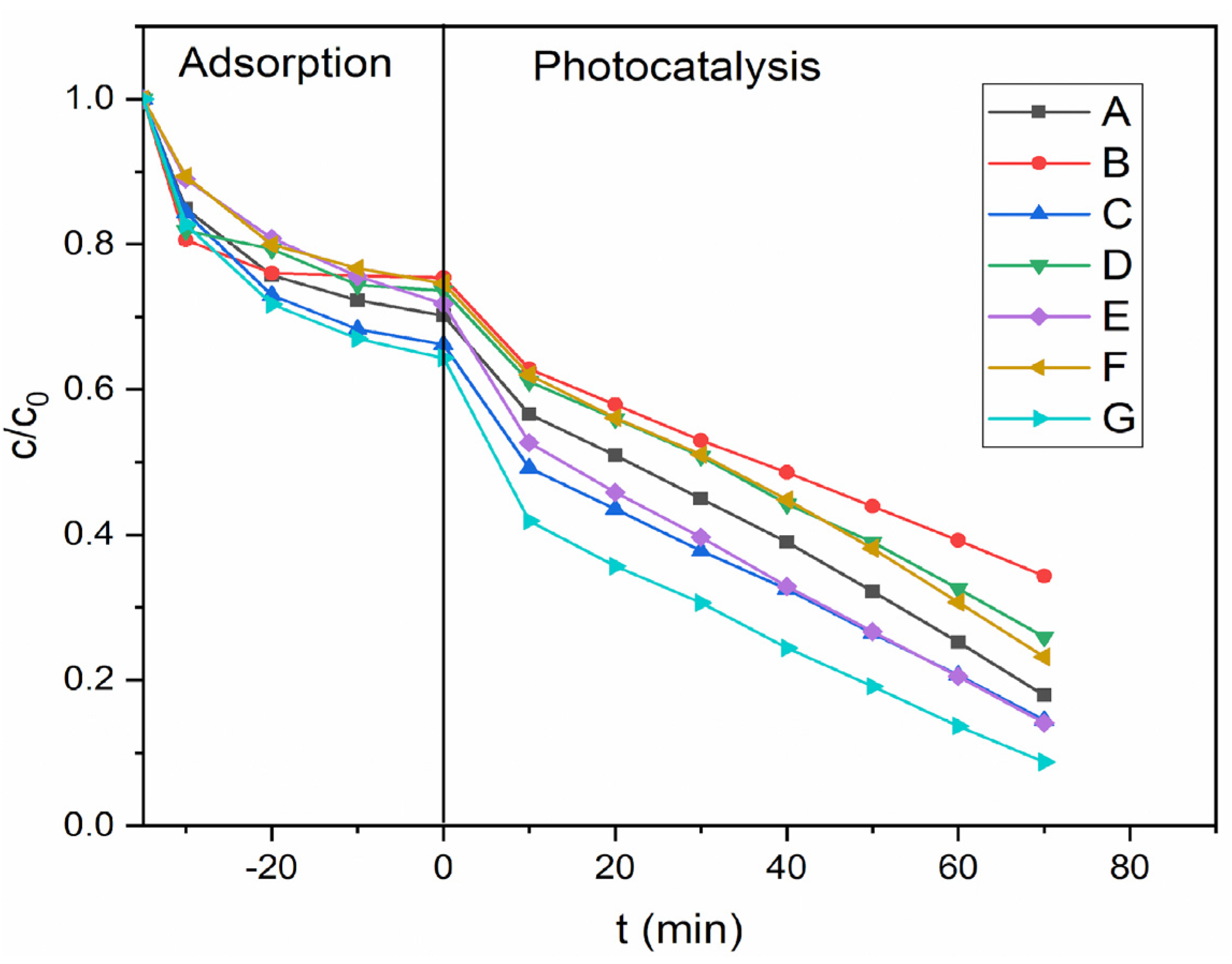
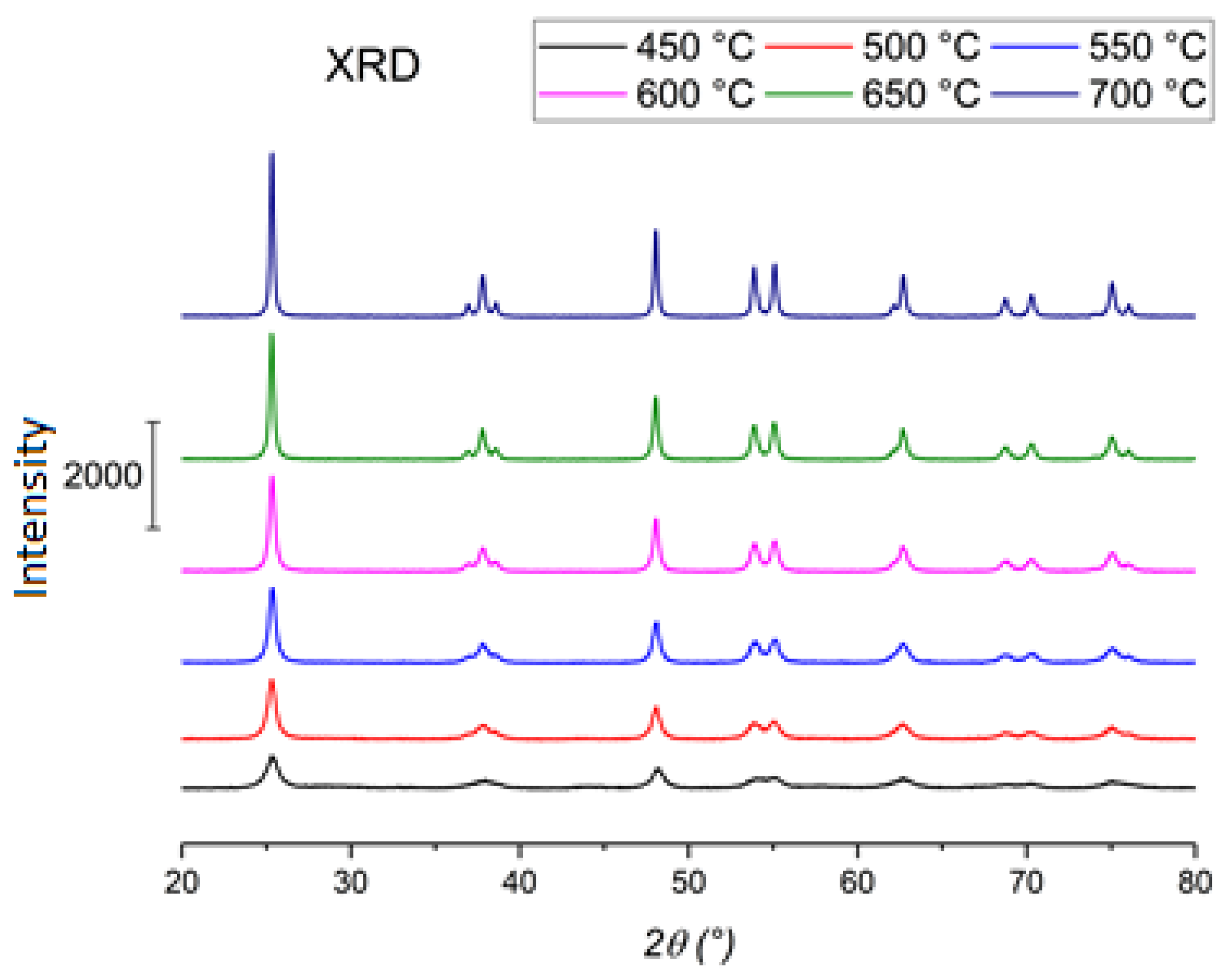
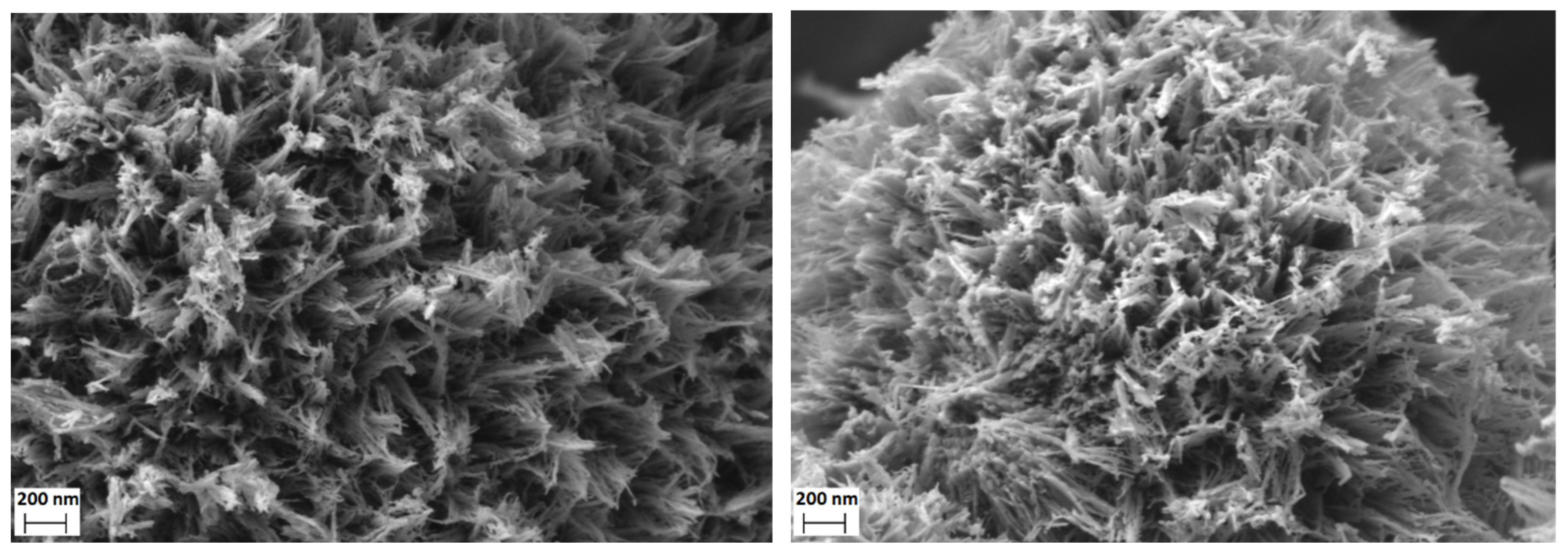
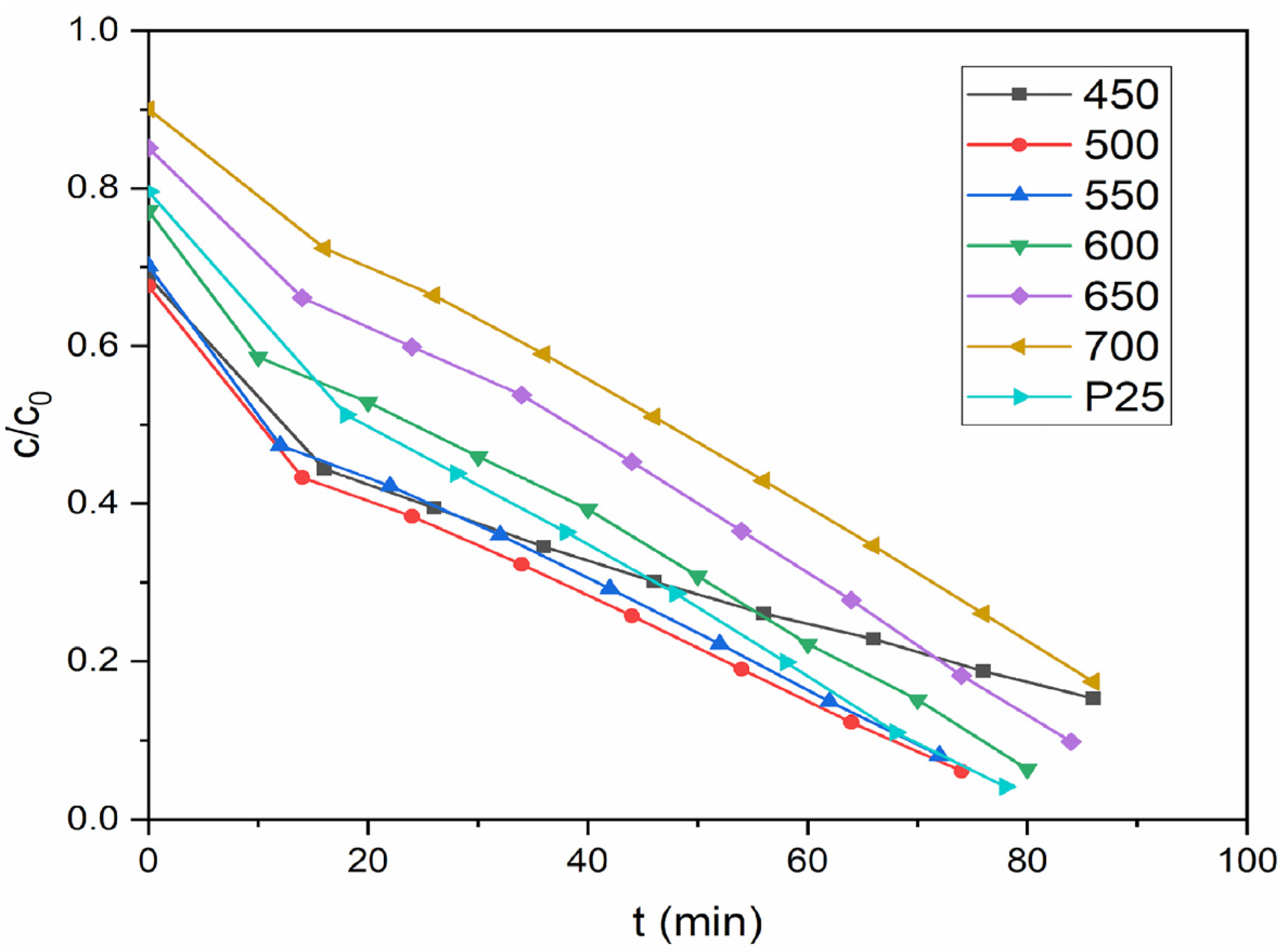
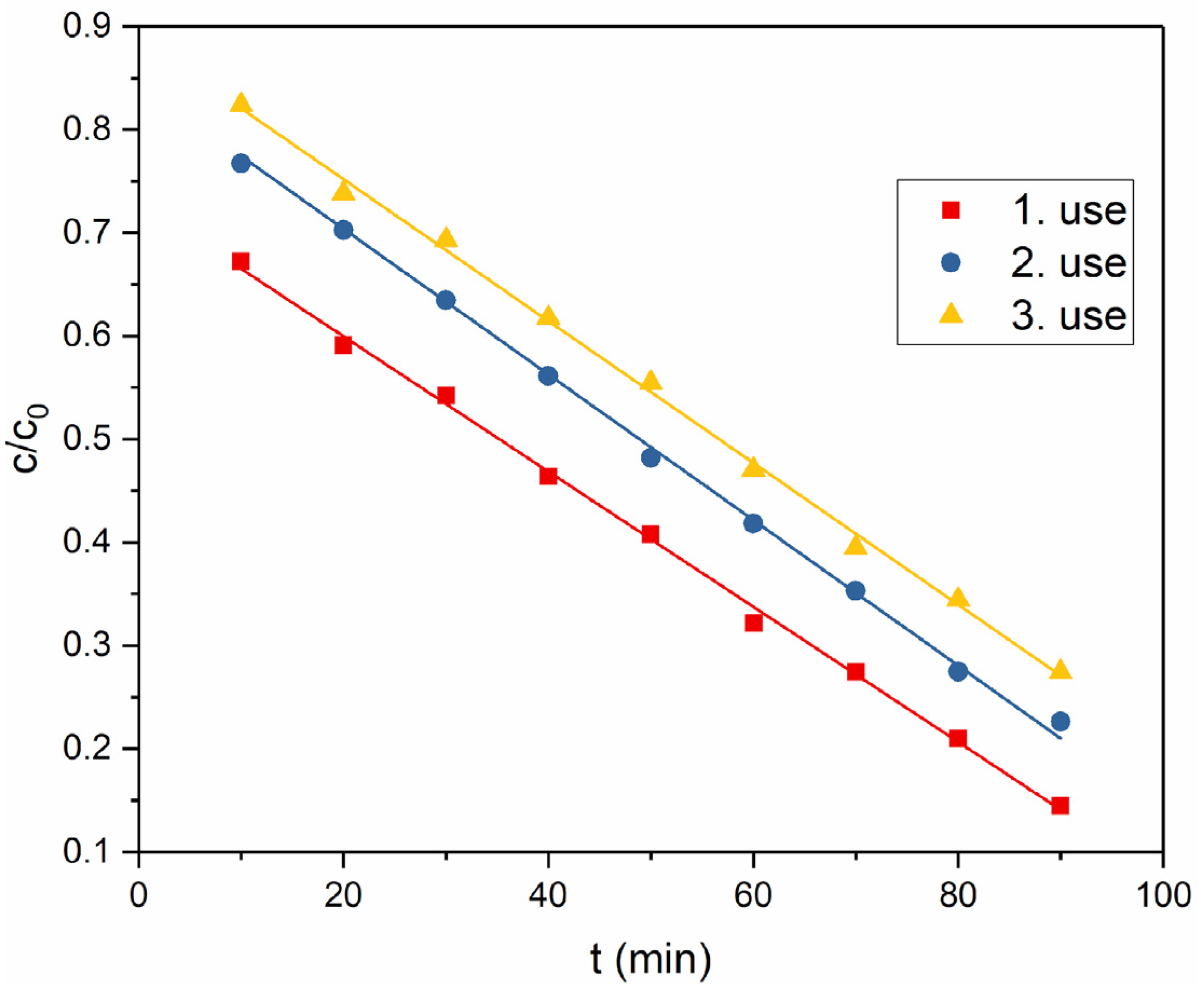

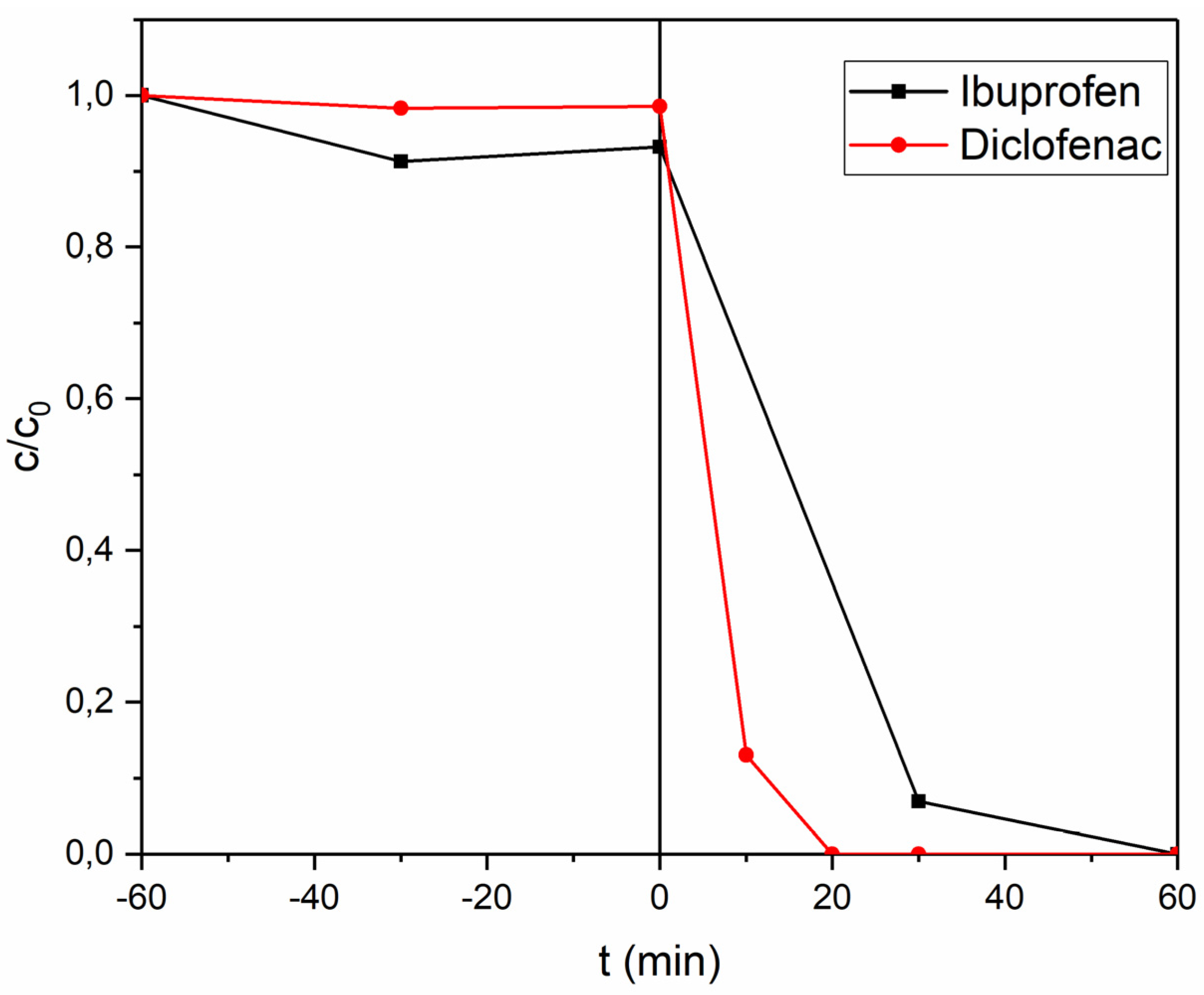
| Sample | Surface Area [m2/g] |
|---|---|
| A | 133 ± 0.7 |
| B | 135 ± 0.9 |
| C | 140 ± 0.9 |
| D | 121 ± 0.7 |
| E | 147 ± 0.8 |
| F | 114 ± 0.8 |
| G | 160 ± 1.4 |
| Sample | k [µg L−1 min−1] |
|---|---|
| A | 76 ± 5 |
| B | 75 ± 2 |
| C | 71 ± 2 |
| D | 75 ± 3 |
| E | 76 ± 6 |
| F | 82 ± 2 |
| G | 69 ± 2 |
| Sample | Surface Area [m2/g] | Crystalite Diameters [nm] |
|---|---|---|
| A-450 | 185 ± 1.2 | 10 |
| A-500 | 133 ± 0.7 | 14 |
| A-550 | 113 ± 0.8 | 18 |
| A-600 | 93 ± 0.7 | 23 |
| A-650 | 55 ± 0.3 | 31 |
| A-700 | 39 ± 0.2 | 44 |
| Sample | k [µg L−1 min−1] |
|---|---|
| P25 | 96 ± 5 |
| A-450 | 49 ± 5 |
| A-500 | 76 ± 5 |
| A-550 | 80 ± 9 |
| A-600 | 90 ± 7 |
| A-650 | 99 ± 4 |
| A-700 | 95 ± 7 |
| Sample | Parameters |
|---|---|
| A | t = 3 h; T = 150 °C; w(NaOH) = 20% |
| B | t = 1.5 h; T = 150 °C; w(NaOH) = 20% |
| C | t = 4.5 h; T = 150 °C; w(NaOH) = 20% |
| D | t = 3 h; T = 120 °C; w(NaOH) = 20% |
| E | t = 3 h; T = 180 °C; w(NaOH) = 20% |
| F | t = 3 h; T = 150 °C; w(NaOH) = 10% |
| G | t = 3 h; T = 150 °C; w(NaOH) = 30% |
Publisher’s Note: MDPI stays neutral with regard to jurisdictional claims in published maps and institutional affiliations. |
© 2021 by the authors. Licensee MDPI, Basel, Switzerland. This article is an open access article distributed under the terms and conditions of the Creative Commons Attribution (CC BY) license (https://creativecommons.org/licenses/by/4.0/).
Share and Cite
Matoh, L.; Žener, B.; Skalar, T.; Štangar, U.L. Synthesis of Nanostructured TiO2 Microparticles with High Surface Area. Catalysts 2021, 11, 1512. https://doi.org/10.3390/catal11121512
Matoh L, Žener B, Skalar T, Štangar UL. Synthesis of Nanostructured TiO2 Microparticles with High Surface Area. Catalysts. 2021; 11(12):1512. https://doi.org/10.3390/catal11121512
Chicago/Turabian StyleMatoh, Lev, Boštjan Žener, Tina Skalar, and Urška Lavrenčič Štangar. 2021. "Synthesis of Nanostructured TiO2 Microparticles with High Surface Area" Catalysts 11, no. 12: 1512. https://doi.org/10.3390/catal11121512
APA StyleMatoh, L., Žener, B., Skalar, T., & Štangar, U. L. (2021). Synthesis of Nanostructured TiO2 Microparticles with High Surface Area. Catalysts, 11(12), 1512. https://doi.org/10.3390/catal11121512








